LIVING in trees is used to describe animals that live among the leaves, branches and trunks of trees. Living on trees applies to animals living on the surface of dead trees or trunks.
Living in the jungle means residing in a densely vegetated tropical rain forest surviving mostly on wild foods.
As such, I was puzzled by the report “Some still believe natives live on trees, laments tourism minister” (June 4). Noting the persistence of outdated stereotyping, Tourism, Arts and Culture Minister Datuk Seri Tiong King Sing said “Some still believe our native people live in the jungle”.
While many Malaysians have a negative connotation of the jungle, such as describing people who acted less civilised as “hutan mari”, meaning from the jungle, I always have a romanticised view of nature, especially jungles, not just the flora and fauna, but also the people living there.
It started when I was a boy watching Tarzan movies and five were made from 1955 to 1960. They were Tarzan’s Hidden Jungle, Tarzan and the Lost Safari, Tarzan’s Fight for Life, Tarzan’s Greatest Adventure, and Tarzan the Magnificent. The 11th Tarzan was played by Gordon Scott.
While staying in the quarters of a tobacco leaf farm near Bukit Tinggi in 1964 , a year before Genting Highlands was opened, I reached puberty. I was working there during the first term school holiday and there was a mountain stream with fish flowing nearby. I had a great time.
In 1974, I brought French tour groups to the National Park, travelling by tour bus from Kuala Lumpur to Tembeling Halt and then by small boats to reach Kuala Tahan. Once, on a boat tour, the tour group witnessed a local landing a big fish, and it became the main menu for our dinner.

About four decades ago, a vagrant was found living on an old frangipani tree at the junction of Jalan Pudu and Jalan Sultan in Kuala Lumpur. Instead of using discarded materials to build a shed from the ground up like squatters do, he built a flimsy shelter on the trunk and branches.
This was the only case I know of a person “living in a tree” anywhere in the world in my entire life. In many countries, tree houses were built for children to play. For tourists, they could choose to stay at luxury treehouse cabins, lodges, hotels, and resorts for getaway holidays.
While many Malaysians immediately take offence when foreigners think that we are still living in trees, I am certainly not.
Stereotyping on anything is all too common and it would be unnecessary and futile to change those who are ignorant or continue to be biased.
Along with millions of other tourists, I too would be most interested to visit any place in our country or around the world where large numbers of people are living in trees. The most isolated tribe is found in North Sentinel Island, Bay of Bengal, but remains out of bounds to outsiders.
Globally, those who live off the land, meaning to live on whatever food one can obtain by hunting, gathering or subsistence farming needs help from the government, and not used as exhibits for visitors to ogle and take videos like some kind of animals.
They include the poor or marginalised living off the grid without access to public supply of electricity and water. Many live in no man’s land at the fringes of farms, plantations and jungles, but none in or on the trees.
In Sarawak, the Dayaks that include Iban, Bidayuh, Kayan, Kenyah and many more traditionally live in longhouses on stilts along rivers near jungles.
They practise diverse cultures, customs and traditions in their daily lives, and are hospitable to visitors looking for memorable experiences.
But if longhouses were to be built in the city for the convenience of visitors, much of the magical experience would be lost.
If they are not located near jungles, a remote countryside or jungle fringe would be good enough. Interestingly, forsaken areas in many cities can look like a jungle. ‒ June 6, 2025
YS Chan is master trainer for Mesra Malaysia and Travel and Tours Enhancement Course and an Asean Tourism Master Trainer. He is also a tourism and transport business consultant.
The views expressed are solely of the author and do not necessarily reflect those of Focus Malaysia.
Main image: Sarawak Tourism Board









